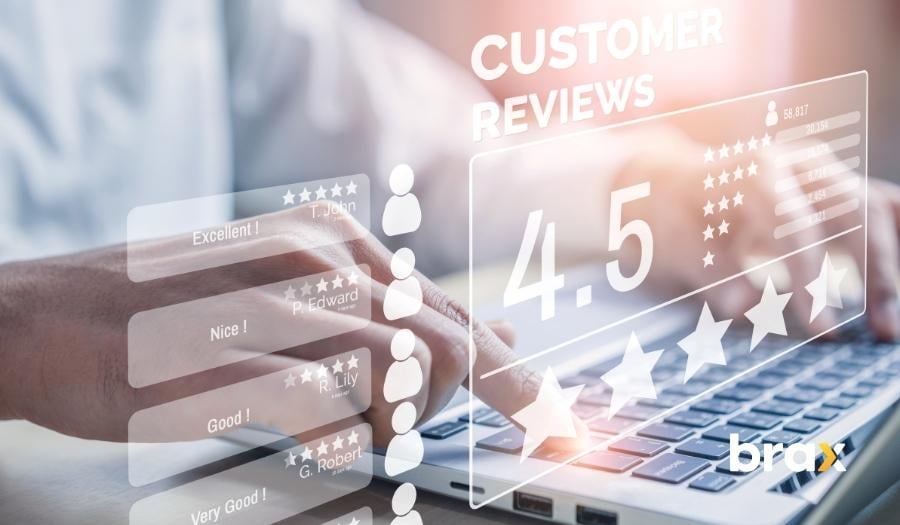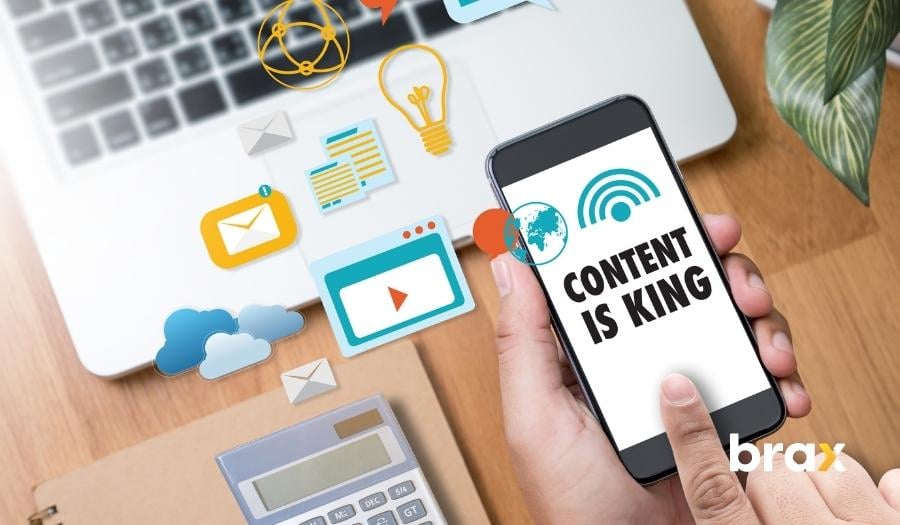Anyone who's tried their hand at online marketing knows that getting traffic to your website or finding audiences for your business's social media pages is only half the battle. The other half, of course, is converting these people into paying customers — and this is not easy.

After all, there are a million and one places for people to spend their money online, so why should they choose to spend it with you? And if you can't get them through the sales funnel, you'll never make a sale. So how do you do it? How do you turn prospects into customers?
Fret not! While not easy, we know the tried and true steps that you need to follow in order to turn customers into actual sales.
Let's go!
6 Steps to Convert Prospects into Customers
Anyone who's ever gone through the process of finding and signing a new customer knows that it's not always an easy task. In fact, according to recent studies, the average conversion rate for sales opportunities is just between 1% to 3%.
So, what does it take to close more deals and turn more prospects into customers? Below are six essential steps that will help you increase your conversion rate and close more business.
1. Know Your Target Audience and What Appeals to Them
Picture this: You're at a networking event. You walk up to someone, introduce yourself, and ask about their business. They tell you all about what they do and how great their product is, but you can't help but zone out. Why? Because they're not talking to you — they're talking at you. And chances are, they're not going to make a sale.
Now picture this: You're at the same networking event, and you walk up to someone and introduce yourself. But instead of going into a monologue about their business, they ask you about yours. They listen intently as you tell them about your needs and your pain points.
They offer helpful advice and resources, and by the end of the conversation, you walk away feeling like you've made a friend. Which person are you more likely to buy from?
The answer is obvious — the second person. And yet so many businesses make the mistake of talking at their prospects instead of talking to them. If you want to convert prospects into customers, it's essential that you know your target audience and what appeals to them. Only then can you craft a message that resonates and create a relationship that lasts.

So how do you go about doing that? Let's take a look.
First, consider who your ideal customer is. What are their demographics? What are their interests? What are their needs? Once you have a clear picture of who your target customer is, you can start to craft a message that speaks to them directly.
Next, think about what appeals to your target customer. Are they looking for quality or quantity? For convenience or customization?
Oftentimes, businesses make the mistake of assuming that everyone wants the same thing — but that couldn't be further from the truth! Consider what sets your product or service apart from the competition and use that to your advantage in your marketing materials.
Finally, remember that relationships are key when converting prospects into customers. No one wants to buy from a faceless corporation — they want to buy from people they know, like, and trust. So take the time to get to know your prospects on a personal level; find out what interests them outside of business hours, and build rapport, so they feel comfortable doing business with you.
2. Create a Strong Offer That’s Difficult to Refuse
When it comes to sales, the old adage "you can't get something for nothing" is especially true. In order to get customers to buy your product or use your service, you need to offer them something that they find valuable — an offer that's difficult to refuse.
One way to create a strong offer is to play on people's fears.
For example, if you're selling a security system, you might offer a free home security assessment to potential customers. This assessment will show them all of the weak points in their current security set-up and make them afraid of what could happen if they don't purchase your product.
Another way to create a strong offer is to appeal to people's vanity.
If you're selling a new line of cosmetics, for example, you might offer a free makeover with the purchase of any two products. This gives potential customers the opportunity to try out your products and see how good they look — an offer that's difficult to refuse!

Lastly, focus on the benefits over the features.
Sure, your product has titanium mixed with gold topped with AI capabilities is such an amazing feature. But how does that help me (the customer)? What pain points does your product solve?
If you say it's unbreakable, looks luxurious, and can be operated remotely by voice command, now that's something I would be interested in looking into! Read more about how to highlight the benefits over the features in this guide.
Whatever method you choose, remember that the key to creating a strong offer is making it relevant to your target audience. Only then will you be able to convert prospects into customers.
3. Use a Variety of Marketing Principles to Convince Your Audience
Once you've found the right people, you'll need to make sure your message is compelling. After all, even the best products won't sell themselves. You'll need to create an advertising campaign that piques peoples' interest and convinces them that your product is worth their hard-earned cash.
Here are my four favorite marketing principles that have been proven to drive results:
-
Create a sense of urgency.
The urgency principle is a simple but effective marketing technique that can be used to convince audiences and convert them into paying customers. By creating a sense of urgency, businesses can prompt potential customers to take action before they miss out on a limited-time offer.
This tactic can be used in a variety of ways, such as running time-sensitive sales or promotions, offering exclusive deals to VIP customers, or even simply sending email countdown timers. When used effectively, the urgency principle can be a powerful tool for driving conversions and boosting sales.
However, it's important to remember that too much urgency can backfire, causing potential customers to feel overwhelmed or even turned off. As with anything in marketing, it's all about striking the right balance.
If people feel like they need to act fast, they're more likely to convert.
You can create urgency by offering a limited-time discount, bonus, or free shipping. Just be sure not to overdo it, as this can turn people away.
-
Include social proof.
Any marketing professional worth their salt knows that social proof is a powerful tool. Simply put, social proof is evidence that other people have found a service to be valuable. This could take the form of testimonials, reviews, or even celebrity endorsements.
The important thing is that it provides potential customers with reassurance that they are making a good decision in choosing your offer. It also reassures customers that what you offer really solves their pain points.
Of course, simply including social proof in your marketing material is not enough. It needs to be used in a way that is both convincing and interesting.
For example, rather than simply listing a bunch of positive reviews, you could focus on one particular customer story that really illustrates the value of your offering. Or, instead of using sterile testimonials, you could incorporate video testimonials from satisfied customers who can speak passionately about your product.
With User Generated Content abounding these days because of social media, it's not hard to convince previous customers to chime in and share their experiences!
By showing potential customers that other people are using and enjoying your service, you can convince them to take the plunge themselves.
After all, if everyone else is doing it, it must be good, right? And if they're happy with the results, that's even better.
Of course, social proof doesn't just apply to individual products or services. You can also use it to show that your brand is trustworthy and reliable. After all, if other people are happy with your brand, that's a strong endorsement.

-
Utilize the Loss Aversion Principle.
Utilizing the loss aversion principle in marketing is an effective way to convince audiences and convert them into paying customers. The loss aversion principle is based on the idea that people are more motivated by the fear of losing something than they are by the prospect of gaining.
In other words, people are more likely to take action to avoid a loss than to achieve a gain. This principle can be used in marketing by stressing the potential losses that customers may incur if they do not purchase a product or service.
For example, a company might highlight the potential financial losses that customers could face if they do not have adequate insurance coverage. By emphasizing the potential losses that customers could suffer, companies can convince audiences to take action and purchase their products or services.
People tend to protect what they have instead of taking risks for uncertain future gains.
This explains why the loss aversion principle is successful in marketing: because it plays on human psychology.
Customers need to feel that their current situation is tenable and that there aren’t any risks involved with sticking with what they know (i.e., their current product or service). Marketing teams need to clearly communicate how their product solves a problem for the customer and how it will make their life easier — without being too “sales-y” about it.
Loss these days isn’t just about material items: it can also refer to saving time, effort, or money. Be clear about what kind of loss your product helps prevent, and you’ll find more successful conversions as a result.
Marketing with loss aversion in mind can help your team get ahead — just be careful not to come off as too pushy! Doing so in an empathetic manner would be ideal.
-
Tell a Story.
This is probably the most overlooked marketing technique that delivers the best results when it comes to converting prospects.
In today's world, there are a lot of ways to get someone's attention. But once you have it, what do you do next? If you're trying to sell them something, how can you convince them that your product is worth their hard-earned money? If you're working in marketing, this is your bread and butter. And one of the most effective tools in your arsenal is storytelling.
The beauty of stories is that they can be used to appeal to just about any emotion: fear, happiness, sadness, anger, love...you name it. And when done well, they can be incredibly persuasive. That's because stories bypass our logical brain and go straight for emotions.
And when we're emotional, we're much more likely to make impulsive decisions — like buying something on the spot.
Of course, not all stories are created equal. In order for a story to be truly effective, it needs to be well-crafted and relevant to your audience. It should also be believable; no one wants to be sold a fairy tale.
But if you can find that sweet spot between entertainment and persuasion, you'll be well on your way to becoming a master storyteller — and an incredibly successful marketer.
Tip: read our article on The Fabled Art of Storytelling in Marketing: the Definitive Guide to master this technique.
4. Nurture Leads Over Time Until They’re Ready to Buy
One of the most effective methods to nurture leads is to offer content that is relevant to their needs and interests. This could include blog posts, e-books, infographics, or even video content.
Content Marketing
By providing helpful and informative content, you'll be able to build trust with your leads and show them that you're an authority in your industry. This is very much like content marketing, which is a long-term strategy that focuses on creating and distributing valuable content to attract and retain customers.
The key difference is that you're specifically targeting leads who are not yet ready to buy, whereas content marketing is more general in nature. By nurturing your leads over time, you'll be top of mind when they are ready to make a purchase.
One important thing to keep in mind is that you shouldn't try to sell them anything in this stage of the relationship. Instead, focus on providing helpful and educational content that will help them solve their problem or answer their question. Once you've built up enough trust, they'll be more likely to buy from you when they're finally ready.

Email Marketing
Another great way to nurture your leads is to stay in touch with them on a regular basis. This could mean sending out monthly newsletters or even just sending a personal email every now and then.
This one is called email marketing. You guessed it: It’s a marketing technique that uses email to build relationships with potential and current customers.
With consistency, you'll be more likely to convert those leads into loyal customers once they make a purchase. If you think that this technique is outdated and will no longer bring you any results, you can't be more wrong!
Have a look at how a small business gathered almost $4,000 in sales by utilizing email marketing.
So there you have it! These are just a few of the many ways you can nurture your leads over time until they're ready to buy.
5. Close the Sale
This is probably the most important step in this guide on how to convert prospects into customers and, essentially, the entire sales process. Whether you're selling a product, a service, or even yourself (as a professional providing wholesome services), the art of closing the deal is essential.
Unfortunately, it's also something that many people find difficult to do. If you're one of those people, don't despair! With a little practice, you can learn how to close the sale like a pro.
Here are four simple tips to get you started:
-
Be confident.
If you don't believe in what you're selling, your prospect never will. So project confidence in your product or service, and be prepared to answer any questions or objections that might come up.
-
Ask for the sale.
This may seem obvious, but it's amazing how many salespeople forget to actually ask for the sale! Once you've made your pitch, simply ask your prospect if they're interested in buying what you're selling.
If they say no, thank them for their time and move on. If they say yes, congratulations — you've just closed the deal!
With online marketing, the best way to ask for the sale is to provide a Call to Action. A call-to-action, also known as CTA, is a button or link that encourages visitors to take a specific action. For example, it could be a button that says “Buy Now” or “Sign Up.”
There are many different types of call-to-actions, but the most effective ones are usually short and to the point. They should also be placed in a prominent position on your website or landing page so that visitors can't miss them.
The following are examples of effective call-to-actions:
- Buy Now
- Sign Up
- Download
- Get Started
- Contact Us
- Subscribe
- Book Now

-
Make it easy to say yes.
Don't try to trick or pressure your prospect into buying something they don't want or need. That will only backfire and make them less likely to buy from you in the future.
Instead, make it easy for them to say yes by providing a clear path to purchase. For example, if you're selling a product online, include a “Buy Now” button on your product page. If you're selling a service, include a pricing page on your website that outlines the different packages you offer.
Don't make them go round and round looking for a way to complete their purchase. Once they get frustrated, they'll probably leave and never come back. By making it easy for prospects to buy from you, you'll be more likely to close the sale.
And don't forget to add incentives, such as free trial, free shipping, huge discounts, and more.
-
Make sure the website is optimized for conversions.
The design and layout of your website can have a big impact on your conversion rate. If your website is difficult to navigate or doesn't look trustworthy, prospects will be less likely to buy from you.
On the other hand, if your website is well-designed and easy to use, you make it easy for them to float through the sales process. Hence, you'll be more likely to convert prospects into paying customers.
Here are some things to keep in mind when designing your website:
- Make sure the overall design is clean and clutter-free.
- Your website should be easy to navigate, with a clear structure and logical hierarchy.
- Include calls to action on every page.
Your website should have a clear purpose — whether it's to sell a product, promote a service, or generate leads.
Also, ensure that your website is mobile-friendly. With more and more people using mobile devices to access the internet, it's important to make sure your website is optimized for mobile. This means that your website should be responsive, meaning it will adjust to fit any screen size.
It should also load quickly and be easy to use on a small screen. If you're not sure how mobile-friendly your website is, you can use Google's Mobile-Friendly Test tool to check.
6. Follow Up with Customers Afterward
Once you've put in the hard work of converting a prospect into an actual paying customer, it's important to follow up with them afterward to ensure they're happy with their purchase and encourage them to return in the future.
There are a few different ways you can go about this.
First, you can reach out to them directly, either via email or phone. This personal touch can go a long way in making customers feel valued.
You can also send out surveys or poll customers on social media and your website to get feedback on their experience.
Finally, don't forget the power of simply saying "thank you" — a genuine expression of gratitude can go a long way in building customer loyalty.
By following up with customers after their purchase, you can turn one-time buyers into lifelong fans.
So, what have we learned?
So there you have it, the techniques on how to convert prospects into customers! While there's no surefire recipe for success, the steps outlined above are a few tried-and-true methods that can undoubtedly help.
By following these simple steps, you can surely turn your audiences into paying customers. So get out there and start building those relationships! Your business will thank you for it in the long run.
And if you need any help along the way, be sure to reach out to Brax for marketing assistance. We're always happy to help convert your customers!
If this article helped you, you might also be interested in the following:
- Cognitive Ease - A Powerful Tactic for Native Advertisers
- Features vs Benefits: WTH is the Difference and Why it Matters
- Warm Up Your Customers With Marketing Funnels
- Mind Control Marketing: How to Leverage Curiosity
- Increase Conversion Rates and Get Higher Quality Customers with Remarketing

